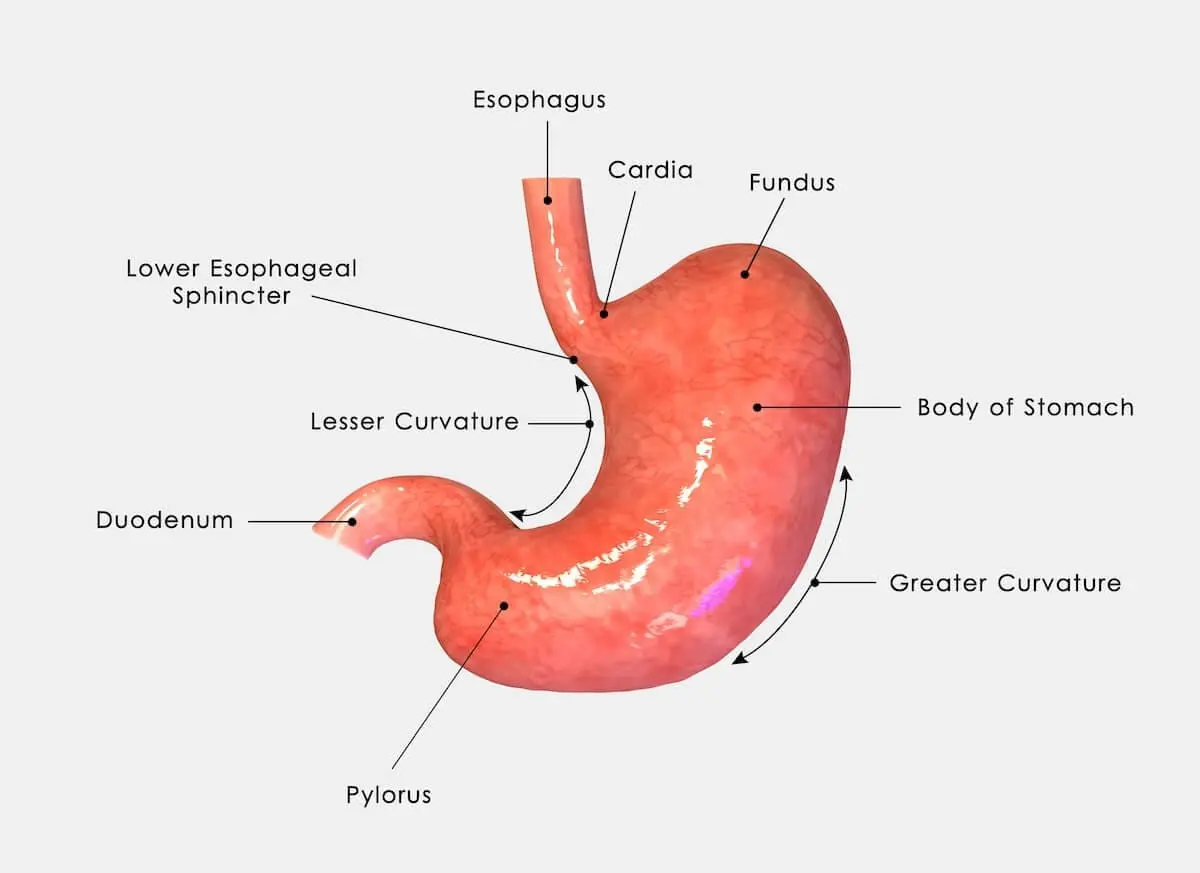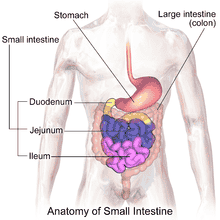Stomach
Table of Contents
Introduction
The stomach is a vital organ in the digestive system responsible for breaking down food and initiating the digestion process. Located in the upper abdomen, it uses stomach acid and enzymes to transform ingested food into a semi-liquid form called chyme, which is then passed to the small intestine for further digestion and nutrient absorption.
Anatomy
Location
It is located intermediate from the esophagus and the duodenum, the stomach is the most extended segment of the gut. It is covered by the peritoneum, which additionally unites it with the other organs. The stomach and liver are joined by the stiff omentum.
The peritoneum has a difficult course that requires visualization for accurate comprehension, therefore review the information below to stay from taking the incorrect turn. The stomach is situated inside the abdominal cavity in a small space known as the stomach bed, and there it rests when lying supine or face up.
Parts
The stomach consists of several essential anatomical factors. The stomach connects four main parts: the cardia, fundus, body, and pyloric element. The stomach consists of several essential anatomical factors. It is the primary segment by which ingested food flows, identifying the inflow part. The fundus, found behind the heart orifice’s horizontal plane, is the stomach’s superior dilatation.
Your stomach consists of five different sections:
- Your stomach’s upper layer is termed the cardia. For existence, the cardiac sphincter inhibits food from establishing through to back up your digestive system.
- It occupies a space inside the diaphragm, an arrangement that assists in respiratory.
- The stomach’s largest element is recognized as the corpus or body.
- The antrum sits within the body. Food is preserved until it is ready to be passed from your stomach to the small intestine.
- The pylorus lives at the bottom of your stomach. It includes the pyloric sphincter.
Anatomical relations of the stomach
- Anteriorly: stomach and the external abdominal wall.
- Posteriorly: The intestines left kidney, glucocorticoid gland, spleen, splenic arterial system, and omental bursa (which is a smaller sac).
- Superiorly: Esophagus and diaphragm
- Inferiorly and laterally: Transverse Mesocolon
Function
It functions to Store food for a brief duration for a few purposes:
- Store food for a brief duration.
- To bring together and break down food, flex and relax.
- Grow cells with particular skills and molecules for food digestion.
Food is metabolized down according to your GI tract into different phases:
- Mouth: Food gets transported into your throat from your tongue for swallowing and digestion. Food gets transported into your throat by your tongue for swallowing and digestion.
- Esophagus: Food may proceed across your esophageal sphincter and enter your stomach because it relaxes at the bottom. (A sphincter is a cylindrical muscle that is capable of its capacity to dilate and relaxing.)
- Stomach: Food is broken down and liquids from digestion are made by your stomach. Food retains its health until the small intestine is cleaned to let it pass through.
- Small intestine: In the process of consuming nutrients and water via meals, your intestinal walls also convey elements to the large intestine.
- Large intestine: Waste materials are converted into waste products in your big intestine. The stool gets pulled into your rectum via it.
- Rectum: The rectum is a designation for the most anterior section in the intestinal tract. It locks on to waste products until you pass gas.
Structure
- Mucosa is the lining that envelopes your stomach. When empty, the mucosa covering your stomach has micro-structures termed rugae.
- Submucosa Neurological cells, blood vessels, lymph vessels (a function of your lymphatic system), and connective tissue are all contained inside your submucosa.
- Muscularis externa is your stomach’s predominant muscular. It eats down food by reducing and increasing its three layers.
- The serosa is a protective barrier coating your stomach.
Blood supply
The stomach’s whole blood supply arises from the abdominal aorta, which is its sole source. Many direct branches and two anastomotic connections follow the stomach’s slopes. In addition, the short and posterior gastric arteries, particularly arising from the splenic artery, maintain an obvious link between the fundus and the upper portion of the stomach.
Condition and disorder
The essence Conditions associated with your stomach are listed as follows:
- Gastric ulcers: degeneration of the stomach padding, inducing pain and bleeding.
- Gastritis: inflammation associated with the stomach.
- Gastroesophageal reflux disease (GERD): When meals from your stomach approach your gastrointestinal tract that causes coughing or heartburn
- Gastroparesis: muscle contractions into your stomach triggered by damage to a nerve.
- Indigestion (dyspepsia): upper stomach discomfort, suffering, or burning.
- Peptic ulcer disease: how much they are ulcers (sores) in your stomach, the duodenum, or the prior segment of your small intestine.
Care
How can I keep my stomach healthy?
- To improve the health of your stomach and digestive system, you can change your habits.
- Drink alcohol in moderation.
- Drink at least 50 ounces of water throughout the day, depending on your amount of exercise and your weight.
- Take from twenty-five to thirty grams of fiber once a week, depending on your gender and age.
- Exercise regularly.
- Eat the fewest junk foods as potential.
- Give up cigarette use and tobacco products.
FAQs
Your stomach is situated in your upper abdomen on the left side of your body. The top of your stomach links to a valve named the esophageal sphincter. The bottom of your stomach links to your small intestine.
The stomach wall consists of up of four layers: the muscularis externa, serosa, submucosa, and mucosa. The mucosa, the innermost layer of the body, mainly comprises gastric glands that secrete stomach juices and have been wrapped in epithelial tissue.
The stomach is an organ with strong, muscular walls that hold food and merge it with enzymes and acid to break it into pieces a liquid or paste.
The stomach is an organ that generates J in the upper part of the stomach (abdomen). It originates in the gastrointestinal tract. It lies between the duodenum, which is the initial part of the small bowel, and the esophagus, which is the final section of the food pipe.
The left gastric, splenic, and common hepatic arteries are the three principal arteries that emerge from the celiac artery.
References
- Sherwood, Lauralee (1997). Human physiology: from cells to systems. Belmont, CA: Wadsworth Pub. Co. ISBN 978-0-314-09245-8. OCLC 35270048.
- Debry, Gérard (1994). Coffee and Health (PDF (eBook)). Montrouge: John Libbey Eurotext. p. 129. ISBN 9782742000371. Retrieved 2015-04-26
- McGuire, Michelle; Beerman, Kathy (2012-01-01). Nutritional Sciences: From Fundamentals to Food (3 ed.). Cengage Learning. p. 419. ISBN 978-1133707387.
- Morris D. Kerstein, Barry Goldberg, Barry Panter, M. David Tilson, Howard Spiro, Gastric Infarction, Gastroenterology, Volume 67, Issue 6, 1974, Pages 1238–1239, ISSN 0016-5085, https://doi.org/10.1016/S0016-5085(19)32710-
- Canadian Cancer Society. Anatomy and physiology of the stomach. https://www.cancer.ca/en/cancer-information/cancer-type/stomach/stomach-cancer/the-stomach Accessed 5/19/2021.
- National Institute of Diabetes and Digestive and Kidney Diseases. Your Digestive System & How it Works. https://www.niddk.nih.gov/health-information/digestive-diseases/digestive-system-how-it-works Accessed 5/19/2021.
- Teach Me Anatomy. The Stomach. https://teachmeanatomy.info/abdomen/gi-tract/stomach/ Accessed 5/19/2021.








7 Comments